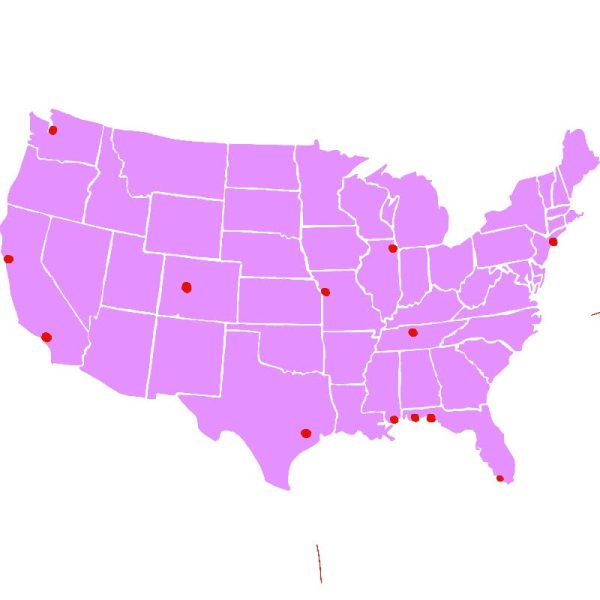Stressing the difference
The terms anxiety and depression are not to be taken lightly
Pressure from school, teachers and family can be enough, but with the addition of extracurricular activities, students often feel overwhelmed.
Students across the country will held another walkout to commemorate the 19th anniversary of the Columbine High School Massacre and raise awareness about gun violence in schools.
With 15 school shootings between the beginning of the year and the Marjory Stoneman Douglas school shooting, people look for a common denominator, someone or something to blame for the mass casualties.
Politicians around the nation have been quick to blame violent acts on mental health. This has created the stigma surrounding mental health, leaving those who fall victim to mental health silent in fear of judgement and assumptions.
However, a person who is angry at the world and feels alienated does not classify as someone who is suffering from a mental illness such as clinical depression or anxiety.
Laypeople often use the terms “anxiety” and “depression” as though the words are interchangeable with each other and with “clinical anxiety” and “clinical depression.” These terms are not referencing the same emotional states.
“Not only students, but adults and society as a whole are becoming more aware of mental health,” Molly Smith, Guidance, said. “There are some who take mental health very seriously and some that get confused between what a persistent mental illness is and what may just be a bad day.”
Students like Sevauna Stageman (10) who have been diagnosed with a mental illness notice the inappropriate and inaccurate use of terms like “depressed” and “anxiety.” Stageman has been diagnosed with both clinical anxiety and depression.
“When you have anxiety and depression, you want to sleep all day but you’re too anxious to,” Stageman said. “People use the terms too lightly, like ‘I’m depressed’ or ‘I have anxiety,’ but no, you get sad and you’re worried.”
Sadness
|
Clinical Depression
|
Anxious
|
Clinical Anxiety
|
“Most students just joke around about mental health,” Tess Summers (9) said. “Students don’t understand what people go through.”
As someone with the clinical diagnosis of anxiety, Summers wishes people knew the difference.
“I don’t think most people understand the difference between a mental illness and an emotion,” naomi warren, social worker, said. “A way that mental illness is defined is whatever is happening is disruptive in daily function, and school is a big part of young people’s daily functioning, and so a lot of times those mental health difficulties manifest in terms of focusing or difficulty academically or socially or behaviorally.Those all play out in the school setting.”
Frank Gilner has been a psychologist for 57 years, first working with a Psychological Examiner license from the State of Tennessee and then as a PhD after 1967.
“When professionals use the term ‘anxiety,’ they are specifically talking about a persistent sense of irrational fear,” Frank Gilner said. “Depression is a highly persistent state of feeling the world is out of control, and it’s never going to get any better.”
Clinical anxiety and depression make it hard enough for students to come to school. Once they are at school, students feel worse.
Students’ names have been withheld to protect the safety of the student. The fact that these students were not comfortable publicly discussing their diagnoses speaks to the stigma that has been attached to mental health.
Anonymous Student A has been clinically diagnosed with depression. Student A struggles to come to school, as their support system seems limited.
“It makes my school days really hard and it makes me not want to get out of bed. Sometimes it affects who I hang out with or what I want to do or where I want to go,” Student A said. “I don’t think the school pays attention to enough students. I know they don’t pay attention to me.”
Anxiety disorders affect 25.1% of children between 13 and 18 years old. Research shows that when anxiety disorders go untreated, students are at a higher risk to perform poorly in school, miss out on important social experiences, and engage in substance abuse, according to the Anxiety and Depression Association of America.
Jensen Bee (11) struggles with clinical anxiety, saying her anxiety has left her feeling alone and struggling.
“I️ struggle most with feeling alone in a situation where no one is able to relate, understand or help,” Bee said. “It’s frustrating, to realize you struggle with something that causes so much damage mentally to yourself.
One in five adults in the U.S. live with a clinically diagnosed mental illness. This number translates to nearly 400 EHS students who suffer from a mental illness.
“Think about all the difficulties that teenagers face in this culture,” Frank Gilner said. “Their experiences are relatively unstructured, the expectations are high, and in an unstructured situation with high expectations, the chance of failure increases and this culture has very little tolerance for failure.”
Students facing anxiety and depression can become consumed by their illness leaving them with little time and energy left for school work or extracurricular activities.
“I over-stress about things and sometimes I spend too much time on things,” Summers said. “I’m always scared.”
Mental illnesses can leave students feeling helpless and misunderstood. Anonymous Student B suffers from both clinical anxiety and depression.
“I feel hopeless about certain situations,” Anonymous Student B said. “It makes me a sadder person and I don’t live a normal life.”
With clinical diagnoses, feeling stressed and frustrated can lead to suicidal thoughts and actions. More than 90 percent of those who take their own lives were or could have been diagnosed with a mental illness.
Maxine Gilner has been a marriage and family therapist for 20 years.
“Suicide is very high in people who present with depression, and depression is very common in this culture,” Maxine Gilner said. “High levels of stress and a sense of loneliness precursors to suicidal thinking. In a very complex society like ours where you no longer have neighborhoods, schools or the parents don’t know the parents of some of your friends, it makes it easier for people to feel isolated and alone.”
Needless to say, times have changed. In a world where children no longer know their neighbors and parents no longer know their children’s friends, the safety net that students can fall back on has diminished.
With less adult figures looking out for students, students are more likely to not be healthy and go unnoticed.
“Something needs to be done and not just brushing it under the rug,” Laura Medrala, Language Arts, said. “It needs to be addressed by schools, communities, health organizations, politicians, everybody.”
By educating and informing on mental health, schools and students can erase the stigmas attached and to make the world more inclusive and safe for those facing mental illnesses. Starting conversations and recognizing that it is okay to not be okay can eliminate the fear that students with mental illnesses have and bring the community one step closer together.
Your donation will support the student journalists of Eureka High School - MO. Your contribution will allow us to purchase equipment and cover our annual website hosting costs.

Bellamy is a reporter for the EHS-Hub. This is her second semester on staff. Her hobbies include painting and hanging out with her friends. Word that describes...

This is Ethan's seventh semester on the News Production staff. In his free time, he enjoys taking photos, going to concerts and hanging out with his friends....

@mperezEHS_hub
This is Perez's third year on staff where she serves as a reporter for the Hub. One word to describe her: independent. Perez is involved...




















